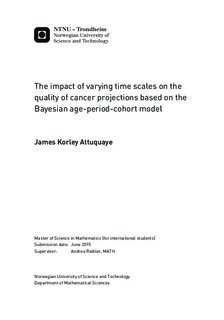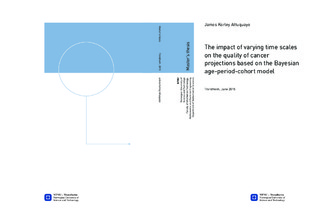| dc.description.abstract | Projection of age-specific cancer incidence and mortality data play an integral role in planning and research. A wide range of methods used for these projections has been developed and put into practice. Many statistical software packages, such as Nordpred and the iterative Lee-Carter package, for projecting age-specific cancer incidence and mortality data implicitly assume that data are aggregated to five-year intervals on the time-scale (periods). However, data aggregation may not always be appropriate and information may get lost. In the field of spatial statistics, care is taken in choosing an appropriate spatial scale to analyse the data of interest; how- ever, less care is taken in choosing an appropriate time-scale in temporal analyses.
In this thesis, the effect of varying temporal scales on the precision and accuracy of projections for selected female cancer mortality data sets from the World Health Organisation Mortality Database is investigated. Three temporal scales have been explored; five-year data aggregation, five-year model-specific aggregation and yearly data structure with no aggregation. Projections are obtained based on these three scales using the BAPC R-package, an R-package which implements Bayesian age- period-cohort (APC) models, where smoothing is applied to each time scale. Also, the hyperpriors for the precision parameter of the smoothing effects are carefully cho- sen to make them transferable between the different time aggregation. The models are estimated using integrated nested Laplace approximations (INLA). Calibration and sharpness of the projections are jointly assessed based on the absolute error and the continuous ranked probability score.
The study shows that annual to five-year data aggregation might not be ideal for projections since clues on yearly trends can not be monitored. However if any form of aggregation needs to be done, then model-specific aggregation might be useful, depending on the application. | |

